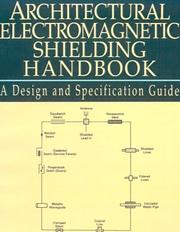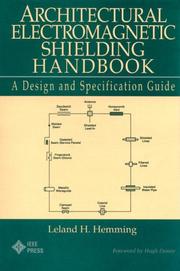| Listing 1 - 10 of 202 | << page >> |
Sort by
|
Book
ISBN: 1559371080 Year: 1991 Publisher: [Place of publication not identified] : IEEE,
Abstract | Keywords | Export | Availability | Bookmark
 Loading...
Loading...Choose an application
- Reference Manager
- EndNote
- RefWorks (Direct export to RefWorks)
Uniform measurement procedures and techniques are provided for determining the effectiveness of electromagnetic shielding enclosures at frequencies from 9 kHz to 18 GHz (extendable to 50 Hz and 100 GHz, respectively) for enclosures having no dimension less than 2.0 m. The types of enclosures covered include, but are not limited to, single-shield or double-shield structures of various construction, such as bolted demountable, welded, or integral with a building; and made of materials such as steel plate, copper or aluminum sheet, screening, hardware cloth, metal foil, or shielding fabrics.
Book
ISBN: 0738152161 Year: 2007 Publisher: [Place of publication not identified] : IEEE,
Abstract | Keywords | Export | Availability | Bookmark
 Loading...
Loading...Choose an application
- Reference Manager
- EndNote
- RefWorks (Direct export to RefWorks)
Uniform measurement procedures and techniques are provided for determining the effectiveness of electromagnetic shielding enclosures at frequencies from 9 kHz to 18 GHz (extendable to 50 Hz and 100 GHz, respectively) for enclosures having all dimension greater than or equal to 2.0 m. The types of enclosures covered include, but are not limited to, single-shield or double-shield structures of various construction, such as bolted demountable, welded, or integral with a building; and made of materials such as steel plate, copper or aluminum sheet, screening, hardware cloth, metal foil, or shielding fabrics.
Book
ISBN: 0738188956 Year: 2014 Publisher: [Place of publication not identified] : IEEE,
Abstract | Keywords | Export | Availability | Bookmark
 Loading...
Loading...Choose an application
- Reference Manager
- EndNote
- RefWorks (Direct export to RefWorks)
This standard provides uniform measurement procedures for determining the shielding effectiveness of electromagnetic (EM) shielding for a variety of enclosures and boxes having all dimensions between 0.1 m and 2 m in the radio frequency range not addressed by IEEE Std 299(TM)-2006. This standard is divided into two parts: Part I - 0.75 m to 2 m and Part II - physically small (<; 0.75 m) but electrically large enclosures. In addition to a number of annexes aiding the measurement of shielding effectiveness of these enclosures, Annex I addresses physically small and electrically small enclosures, and Annex J addresses electrically small enclosures in reverberation chambers. Problems occurring in the testing of small enclosures having linear dimension less than 2 m are very different from determining the shielding effectiveness of large rooms and broad depending on the actual size of the enclosure itself. A number of other annexes are included that address rationale, mathematical formulas, selection of measurement techniques, preliminary measurement and repairs, wall-mounted monopoles, impedance mismatch correction, and using isolated monopoles in outer reverberation chambers.

ISBN: 0780360249 047054418X 9780470544181 9780780360242 Year: 1992 Publisher: Piscataway, New Jersey [Piscataqay, New Jersey] IEEE Press IEEE Xplore
Abstract | Keywords | Export | Availability | Bookmark
 Loading...
Loading...Choose an application
- Reference Manager
- EndNote
- RefWorks (Direct export to RefWorks)
The first volume ever to cover all aspects of the subject, Architectural Electromagnetic Shielding Handbook provides the practicing architect/engineer with a comprehensive guide to electromagnetic shielding. This practical handbook is a one-stop source for every form of shielding enclosure now used in commercial and government test laboratories, communication and computer centers, and electromagnetic hardened facilities designed to prevent electromagnetic interference (EMI) from reaching either a sensitive piece of equipment or an unauthorized agency. Additional features include: . extensive supporting information on penetrations such as doors, vents, piping, and electromagnetic filters for each type of shielding. complete descriptions of modular, welded, and architectural forms of shielding as well as design checklists for shielded enclosure installation. detailed descriptions of performance specifications and methods of testing necessary to prove performance Now you can have practical design and manufacturing techniques for solving ESD problems associated with sophisticated equipment used in a home or office environment. This book takes the mystery out of ESD by showing how it is generated and how it affects electronic devices, such as integrated circuits. It provides practical guidelines and the rationale on how ESD solutions can work for you.
Book
ISBN: 1281284939 9786611284930 0470268484 0470268476 9780470268483 9780470055366 Year: 2008 Publisher: Hoboken, New Jersey [Piscataqay, New Jersey] Wiley-Interscience IEEE Xplore
Abstract | Keywords | Export | Availability | Bookmark
 Loading...
Loading...Choose an application
- Reference Manager
- EndNote
- RefWorks (Direct export to RefWorks)
The definitive reference on electromagnetic shielding materials, configurations, approaches, and analyses This reference provides a comprehensive survey of options for the reduction of the electromagnetic field levels in prescribed areas. After an introduction and an overview of available materials, it discusses figures of merit for shielding configurations, the shielding effectiveness of stratified media, numerical methods for shielding analyses, apertures in planar metal screens, enclosures, and cable shielding. Up to date and comprehensive, Electromagnetic Shielding: . Explores new and innovative techniques in electromagnetic shielding. Presents a critical approach to electromagnetic shielding that highlights the limits of formulations based on plane-wave sources. Analyzes aspects not normally considered in electromagnetic shielding, such as the effects of the content of the shielding enclosures. Includes references at the end of each chapter to facilitate further study The last three chapters discuss frequency-selective shielding, shielding design procedures, and uncommon ways of shielding--areas ripe for further research. This is an authoritative, hands-on resource for practicing telecommunications and electrical engineers, as well as researchers in industry and academia who are involved in the design and analysis of electromagnetic shielding structures.

ISBN: 0879422874 9780879422875 Year: 1992 Publisher: New York (N.Y.): IEEE,
Abstract | Keywords | Export | Availability | Bookmark
 Loading...
Loading...Choose an application
- Reference Manager
- EndNote
- RefWorks (Direct export to RefWorks)
Book
Year: 1992 Publisher: Piscataway, New Jersey : [Piscataqay, New Jersey] : IEEE Press, IEEE Xplore,
Abstract | Keywords | Export | Availability | Bookmark
 Loading...
Loading...Choose an application
- Reference Manager
- EndNote
- RefWorks (Direct export to RefWorks)
The first volume ever to cover all aspects of the subject, Architectural Electromagnetic Shielding Handbook provides the practicing architect/engineer with a comprehensive guide to electromagnetic shielding. This practical handbook is a one-stop source for every form of shielding enclosure now used in commercial and government test laboratories, communication and computer centers, and electromagnetic hardened facilities designed to prevent electromagnetic interference (EMI) from reaching either a sensitive piece of equipment or an unauthorized agency. Additional features include: . extensive supporting information on penetrations such as doors, vents, piping, and electromagnetic filters for each type of shielding. complete descriptions of modular, welded, and architectural forms of shielding as well as design checklists for shielded enclosure installation. detailed descriptions of performance specifications and methods of testing necessary to prove performance Now you can have practical design and manufacturing techniques for solving ESD problems associated with sophisticated equipment used in a home or office environment. This book takes the mystery out of ESD by showing how it is generated and how it affects electronic devices, such as integrated circuits. It provides practical guidelines and the rationale on how ESD solutions can work for you.
Book
Year: 1957 Publisher: London : Pergamon,
Abstract | Keywords | Export | Availability | Bookmark
 Loading...
Loading...Choose an application
- Reference Manager
- EndNote
- RefWorks (Direct export to RefWorks)
Book
ISBN: 0738156310 0738156329 Year: 2007 Publisher: New York : IEEE,
Abstract | Keywords | Export | Availability | Bookmark
 Loading...
Loading...Choose an application
- Reference Manager
- EndNote
- RefWorks (Direct export to RefWorks)
Tests and measurements that are performed on shielded power cables to identify the location of a fault are described. Whenever possible, the limitations of a particular test and measurement to locate a fault are provided and recommendations are made regarding specialized fault-locating techniques. A fault characterization chart is included as an aid to select a fault-locating technique.
Book
Year: 1970 Publisher: Berlin: Springer,
Abstract | Keywords | Export | Availability | Bookmark
 Loading...
Loading...Choose an application
- Reference Manager
- EndNote
- RefWorks (Direct export to RefWorks)
| Listing 1 - 10 of 202 | << page >> |
Sort by
|

 Search
Search Feedback
Feedback About UniCat
About UniCat  Help
Help News
News